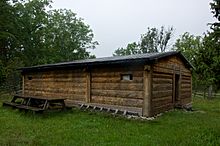Fjales in Ala
The Fjäle desert in Ala is located on the Swedish island of Gotland at the end of a forest path that branches off Länsväg 143 about three kilometers south of the church of Ala in a westerly direction . The path crosses a non-drained moor . The desert has the character of a meadow, as the square has been used as a meadow for the past centuries . In the southeast of the facility there is a reconstructed house and a stable building.
The site
The terrain consists of a small hill with a thin humus cover , which merges into rocky soil to the south. Below the hill, the soil layer is drier and more suitable for cultivation.
The name
The name of the desert is not documented in any written source, but based on the field names "Fjäler Wiese" and "Fjäler Moor" the conclusion that the farm was also called "Fjäle" is not very daring. This farm name is attested in several places on the island. In the parish of Anga, a secluded courtyard also bears this name.
The tradition
Fjale was mapped during the national survey in 1700 . The surveyor found the remains of a house, and based on information from contemporary farmers, he carried a "ruin of the Fjale lad's house". According to tradition, the Fjälebursche was a defiant farmer who - according to legend - had the priest slain in the church because he had started the service before the Fjälebursche had arrived. He is said to be buried in Ala's cemetery.
The yard
The fjale area, which was previously largely unknown archaeologically, was discovered in the early 1970s. The investigations, which began in 1976, were carried out in various stages over a decade. The meadow and the nearby areas housed a courtyard with fields, wells, fences, buildings, roads, cattle paths and meadows. There is also a pre-Christian burial ground for the residents of the farm.
The oldest building consists of a house foundation of about 22 × 8 m. Coin finds show that this farm has been cultivated since the middle of the late Iron Age . Towards the end of the 6th century (in the Vendel period ) the farm was relocated. The new farm is a good 100 m north of the old one. A new construction was chosen for the house. Roof-bearing walls were braced with earth-fixed corner and wall posts that had grooves into which planks were inserted. This represents an early form of timber house construction, which has survived as a construction principle to the present day. The construction could be reconstructed using post holes and stone foundations. The youngest house - called "Fjale lad's house" by the surveyor - has been fully examined. The dating of the finds shows that the property was abandoned in the mid-14th century.
The arable area was about 20 hectares. Fjäle was a big farm. The well-preserved fields are located immediately north of the building complex. The field boundaries are clearly visible in the form of walls and terrace edges. Fields and meadows were surrounded by walls or wooden fences. When the walls were demolished, strands of stone remained in the ground.
The cemetery
The pre-Christian burial place of the courtyard is on rocky ground about 400 m south of the courtyard buildings. The graves examined revealed dates from the early Vendel period up to and including the Viking Age . The Wendelzeit graves are mostly of the same construction as on the cemetery of Trullhalsar .
The meaning
The burial ground and the remains of the building were reconstructed based on the results of the investigation. Because of its isolated location and especially the lack of later agriculture, Fjäle is one of the best preserved desert areas in Sweden. The investigations made an important contribution to the understanding of the Gotland courts and the development of the cultural landscape during the Vendel Period , the Viking Age and the early Middle Ages . A cultural trail with information boards leads through the area.
literature
- Dan Carlsson: The Gotland court during the younger Iron Age - the Middle Ages. The research project Fjäle in Ala. In: Sven-Olof Lindquist (Ed.): Society and trade in the Baltic during the Viking Age (= Acta Visbyensia. Vol. 7, ISSN 0065-1702 ). Gotland Fornsal, Visby 1985, pp. 273-280.
Web links
- Fjäle in Ala - entry in the database "Fornsök" des Riksantikvarieämbetet (Swedish)
Coordinates: 57 ° 23 ′ 25.5 ″ N , 18 ° 37 ′ 10.9 ″ E




